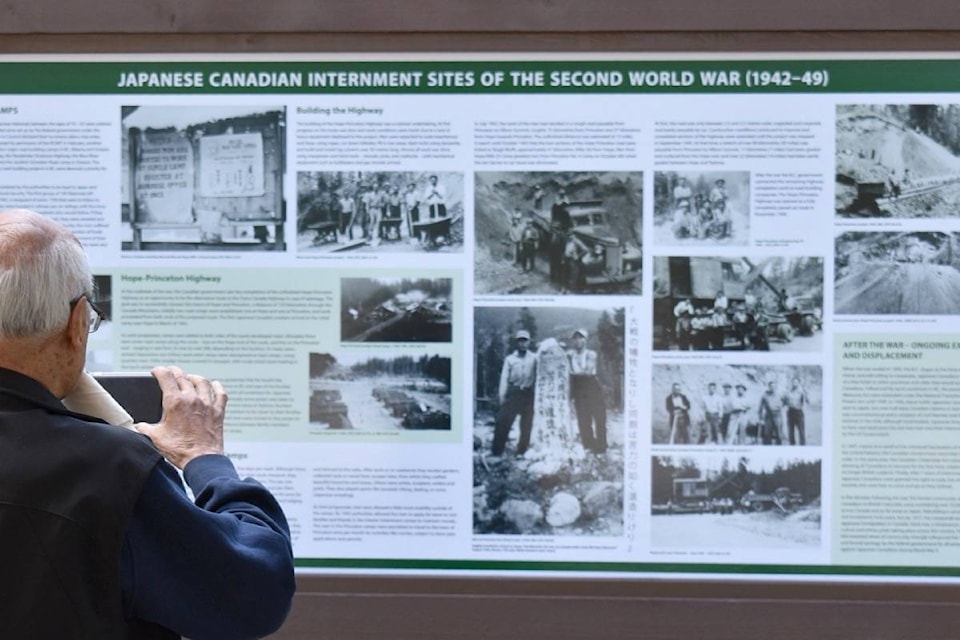The lesser-known story of the Japanese-Canadian men who built B.C.’s highways during World War II, connecting parts of the vast province while enduring massive personal hardship, is now memorialized on a recently-erected sign at Mile 9 along the Hope-Princeton Highway.
Survivors and descendants of Japanese-Canadians who were forcibly relocated from coastal areas of B.C. to internment camps in the Interior during World War II, as well as dignitaries and partners on the project, unveiled the legacy sign Sept. 7. It is one of eight signs along B.C. interior highways, the last of which will be unveiled on Sept. 28, all with a goal of educating Canadians on a dark chapter hidden from public awareness for decades.
RELATED: Sunshine Valley Tashme Museum receives Heritage BC award
“While women and children were sent to internment camps, what is little known is that about 1,700 able-bodied Japanese-Canadian men aged 18 to 45 years old, were sent to road camps to build Highway 3, the Hope-Princeton Highway, Highway 1, Revelstoke-Sicamous Highway, and…Highway 5, as forced labour,” said Laura Saimoto, who worked on the legacy sign project as part of the Japanese Canadian Legacy Committee.
“These highways were deemed a priority for national security by the Canadian government. And in the case of Hope-Princeton Highway, the government saw it as an alternative route to Highway 1 in case of enemy sabotage.”
Work on Highway 3 started in March 1942 at both ends in Hope and Princeton, Saimoto said. There were seven camps along the 133 km distance, the plan was to have the work meet in the middle at Allison Pass. By 1945 the road camps were shut down, at which time the highway was passable. It was later paved by contractors in 1949.
Howard Shimokura, who was interned at Tashme, located in what is now the Sunshine Valley recreational community, detailed the hardships workers faced.
“For three-plus years these men worked hard, under very tough conditions, while living in makeshift camps in remote locations. In the beginning, they worked with picks, shovels and wheelbarrows and only later was heavy duty road construction equipment brought in. They were paid very nominal wages, and they suffered from isolation, loneliness and very few recreational opportunities. However, they adapted through perseverance and resilience, while maintaining loyalty to Canada despite their hardships,” Shimokura said.
Kazuo ‘Kaz’ Yonemura was one of the young men relocated to the road camps. As he sat in the audience Sept. 7, Saimoto recounted his family history.
Born in 1923, Kaz grew up on Vancouver Island. His father worked as a millwright and carpenter at sawmills. When war broke out, the family was relocated to Hastings Park and from there Kaz was ordered to join the Number 2 Yard Creek Camp on the Revelstoke-Sicamous highway. His parents and siblings went to Tashme.
RELATED: Sunshine Valley pays homage to karizumai
Kaz’ role was to haul wood used for cooking, heating and heating water in the camp. Workers lived in bunkhouses and were paid well under the rate of Caucasian workers while having to pay for room and board of their 25 cents an hour wages.
“What he remembers is that fortunately, they had a good cook in the camp. So good, in fact, that workers in other camps would come around for meals,” Saimoto said.
“There was sickness, unrest and lack of morale in the camps. Men were given permits to town, or to visit their families, to help build morale. Kaz remembers he got a pass to visit his parents in Tashme Christmas of 1942 and in 1945.”
Saimoto said separation from family was one of the main issues of contention between the workers and the government during internment.
“As a young 18-year-old, second-generation Canadian, Kaz was already working in logging camps since Grade 8 to help support his family. He says it wasn’t that hard on him to be away from his family, but for the other young men it was their first time away from home, and they got homesick,” Saimoto said.
Many of the dignitaries and speakers recognized the significance of recognizing this history, decades later.
“Seventy six years ago, to the east of us, was the largest and closest interment camp to the West Coast, that’s why it’s so great to see so many of us here today to honour this historic site and acknowledge one of the darkest parts of Canadian history, so we can move forward together in the light,” said Dennis Adamson, Fraser Valley Regional District director for Area B where both the Tashme camp and some of the road camps were located.
“The Japanese-Canadian story teaches us about racism, about social injustice and how acted out and driven by fear and hysteria can shatter families and communities. At the same time, it also teaches us about the courage, fortitude and resilience of the human spirit, in spite of overwhelming circumstances in our lives,” Saimoto said. “It teaches us to appreciate the good cook in the camp, to appreciate that you are able to see a Christmas concert and visit your family in Tashme and it teaches us that we have privilege and responsibility to connect.”
With representatives of the provincial government present at the unveiling, Saimoto joked the Japanese Canadian Legacy Committee would ‘kick their ass once in a while’ to ensure the signs are maintained. To which MLA Bowinn Ma replied the government would certainly do their part.
RELATED: Education planned on B.C.’s racist history
Is there more to this story?
news@hopestandard.com
Like us on Facebook and follow us on Twitter
